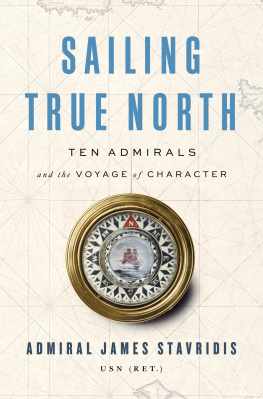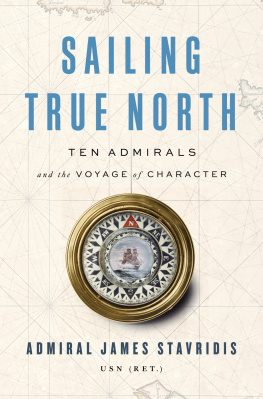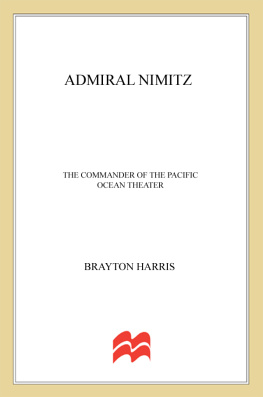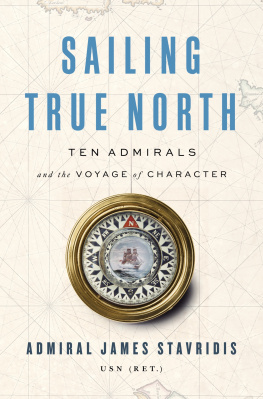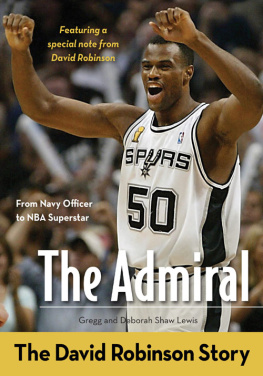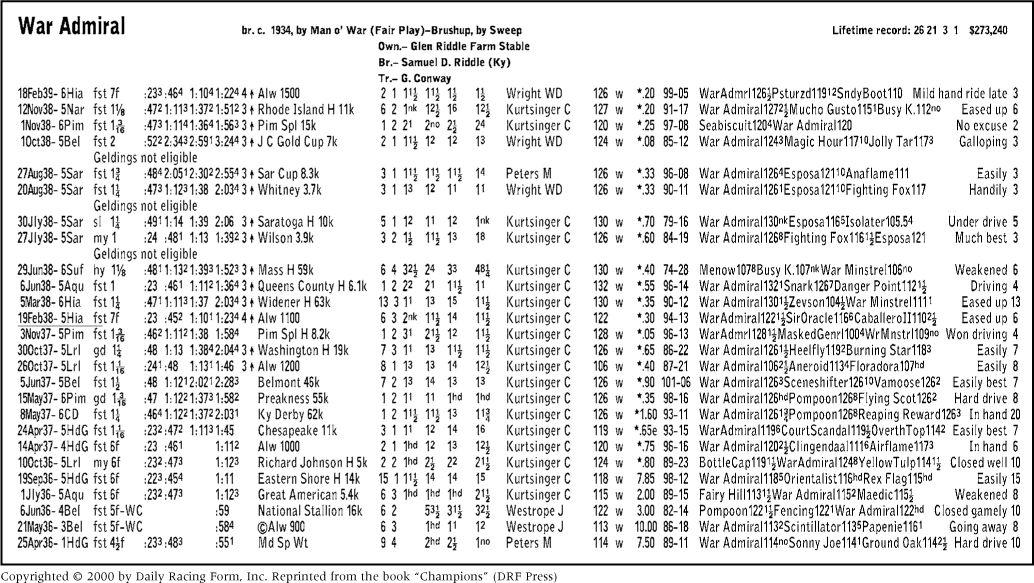E dward L. Bowen is the author of more than twenty books on Thoroughbred racing history. He was a staff member of the weekly trade publication The Blood-Horse for some thirty years, including seventeen as managing editor and five as editor-in-chief. He was also editor of The Canadian Horse for two years. Bowen served as president of the Grayson-Jockey Club Research Foundation from 1994 through 2018. Bowen has received various honors within the world of Thoroughbred and sports journalism and authorship, including an Eclipse Award for magazine writing, the Charles W. Engelhard Award from the Kentucky Thoroughbred Association, the Old Hilltop Award from Pimlico Race Course, the Walter Haight Award from the National Turf Writers Association, and the gold medal designation in Forewords sports category. He resides in Versailles, Kentucky.
WAR ADMIRALs
WAR ADMIRALs RACE RECORD
Page 1: War Admiral (The Blood-Horse); War Admiral head shot (Morgan Photo Service)
Page 2: Fair Play (The Blood-Horse); Man o War (Keeneland-McClure); Sweep (The Blood-Horse); Brushup (The Blood-Horse)
Page 3: Samuel D. Riddle (Morgan Photo Service); George Conway and George Cassidy (C.C. Cook); Charley Kurtsinger aboard War Admiral (The Blood-Horse)
Page 4: Conway watching his horses (Joe Fleischer); After winning the Chesapeake (Morgan Photo Service)
Page 5: Winning the Kentucky Derby; in the Derby winners circle (both The Blood-Horse); Winning the Preakness (Morgan Photo Service)
Page 6: Winning the Belmont (NYRA); Returning to winners circle (Morgan Photo Service); Belmont trophy presentation (Keeneland-Morgan)
Page 7: War Admiral with Mrs. Riddle and Conway (Morgan Photo Service); Winning the Washington Handicap (Turf Pix); Winning the Heather Purse (The Blood-Horse)
Page 8: In the Widener Cup (Keeneland-Morgan); Training at Hialeah (C.C. Cook); At Hialeah with Conway (C.C. Cook)
Page 9: Winning the Saratoga Handicap (Keeneland-Morgan); Winning the Whitney and the Saratoga Cup (both Keeneland-Cook)
Page 10: Winning the Jockey Club Gold Cup (Keeneland-Morgan); Gold Cup winners circle (Keeneland-Cook)
Page 11: C.S. Howard and Riddle (Joe Fleischer); War Admiral with Riddle (Joe Fleischer); War Admiral acting up (Intl News Photograph Service)
Page 12: Seabiscuit and War Admiral each work for match race (both Joe Fleischer)
Page 13: Pimlico Special match race post parade; Seabiscuit wins match race (both Joe Fleischer)
Page 14: War Admiral arrives in Lexington (The Blood-Horse); War Admiral with Will Harbut (Jack Wilkes/LIFE Magazine)
Page 15: Searching (Bert and Richard Morgan); Busher (Bert Morgan); Blue Peter (Marshall Hawkins); Busanda (Bert Morgan)
Page 16: War Admiral at Hamburg Place (Warren Schraeder); Gravestone (Lucy Zeh)
W AR A DMIRAL
C ollectively, the sons and daughters of Man o War added to the exalted status of the flashy animal who had become a national hero as the decade of World War I segued into the dawn of the roaring twenties. There was about Man o Wars career at stud none of the scent of disappointment or qualified success of latter day Titans Citation and Secretariat. Man o War led the sire list, set records, and begot fiery, classic colts and elegant, staying fillies.
Still, no one son could emerge as the equal of the sire. Fact probably supported this, but legend guaranteed it. Around Man o War was a heroic aura that was abetted over the years by the lyric resonance of one Will Harbut. As Man o Wars groom over much of his life, Harbut took it upon himself to dramatize the facts to thousands of visitors who made the pilgrimage to Faraway Farm to look upon the wonder horse.
The saga of Man o War stood on its own merits, as well. He was bred by Major August Belmont II, for many years the most prominent racing man in America, breeder and owner of champions, chairman of The Jockey Club, racing commissioner a veritable one-man legislative, judicial, and executive branch combined. Belmonts commitment to the Cape Cod Canal project diminished his business fortunes, and when World War I further complicated his personal circumstances, he decided he should sell most of his yearling crop of 1918 rather than retain the horses to race. Belmont was in his sixties but found a way to help the war effort. He took a post in Spain with the Quartermaster Corps to procure supplies for the American Expeditionary Forces.
Belmont held several fillies out of his sale, to preserve them as future broodmares, and he flirted with the idea of holding out one particular colt. This was a chestnut son of Belmonts high-class racehorse and exceptional stallion Fair Play. The colts dam, Mahubah, was a daughter of English Triple Crown winner Rock Sand.
Belmont had been unsuccessful in peddling packages of his yearlings privately, so a draft wound up at auction at Saratoga in the summer of 1918. Man o War did not top the sale, but at five thousand dollars was a pretty expensive purchase at the time. The winning bid was placed on behalf of Samuel D. Riddle, a sportsman of merit who had been a foxhunter, show-horse exhibitor and trainer, as well as having raced a stable of flat runners.
Riddle was a sort of Clarence Day among sportsmen. Like the Broadway character in the play Life With Father, Riddle was possessed of considerable self assurance, and perhaps not overly concerned with the rights or sensibilities of others. We have this via Riddles own words, for he was quoted late in life of his decision to be nice to everyone, appending I wasnt always. Others saw in Riddle a likeness to a Roman senator.
Harry Scott, the Kentucky horseman whose father managed Faraway Farm for the Riddle family, recalls from his own youth that the irascibility of Riddle was pivotal to the career of Man o Wars son, War Admiral. As Scott recalls with wry humor, Riddle was not impressed with the brown colt, War Admiral being more in the runtish image of his dam, the little bay Brushup, than in the proud and masculine golden bronze of his high-headed sire.
Riddle owned Faraway with fellow sportsman and racing leader Walter M. Jeffords Sr., whose wife was the niece of Riddles wife. While the two elements of the family held Faraway together, until Riddle eventually decreed that it should be split, the two raced separate and competing stables. There were various instances of Riddle versus Jeffords clashes, which must have created a certain tension around the dinner table. Indeed, the Jeffordses purchased Golden Broom out of the same Saratoga auction from which Riddle acquired Man o War. Golden Broom three times beat Man o War in schooling trials, although no match for the colt beloved as Big Red once they got into actual competition. In a more benign, cooperative form of competition, Mrs. Sarah Jeffords entered her Hoodwink against Man o War for the 1920 Lawrence Realization so that the event was a two-horse race rather than a walkover. Man o War made little distinction between that race and a walkover and won by one hundred lengths.





